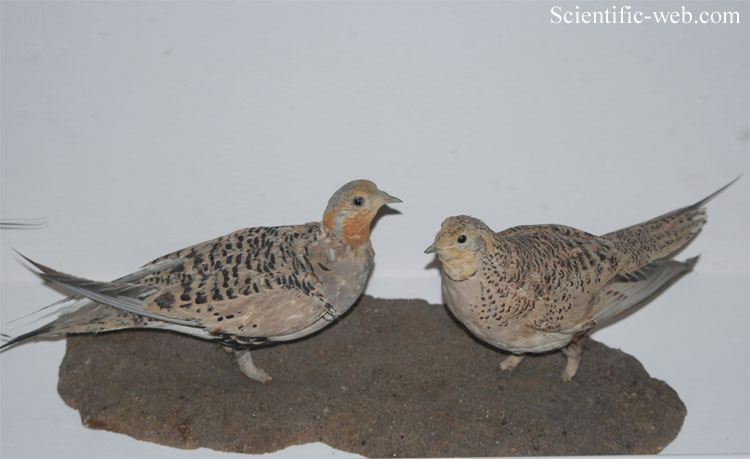
Syrrhaptes paradoxus, Photo: Michael Lahanas
Superregnum: Eukaryota
Cladus: Unikonta
Cladus: Opisthokonta
Cladus: Holozoa
Regnum: Animalia
Subregnum: Eumetazoa
Cladus: Bilateria
Cladus: Nephrozoa
Superphylum: Deuterostomia
Phylum: Chordata
Subphylum: Vertebrata
Infraphylum: Gnathostomata
Megaclassis: Osteichthyes
Cladus: Sarcopterygii
Cladus: Rhipidistia
Cladus: Tetrapodomorpha
Cladus: Eotetrapodiformes
Cladus: Elpistostegalia
Superclassis: Tetrapoda
Cladus: Reptiliomorpha
Cladus: Amniota
Classis: Reptilia
Cladus: Eureptilia
Cladus: Romeriida
Subclassis: Diapsida
Cladus: Sauria
Infraclassis: Archosauromorpha
Cladus: Crurotarsi
Divisio: Archosauria
Cladus: Avemetatarsalia
Cladus: Ornithodira
Subtaxon: Dinosauromorpha
Cladus: Dinosauriformes
Cladus: Dracohors
Cladus: Dinosauria
Ordo: Saurischia
Cladus: Eusaurischia
Subordo: Theropoda
Cladus: Neotheropoda
Cladus: Averostra
Cladus: Tetanurae
Cladus: Avetheropoda
Cladus: Coelurosauria
Cladus: Tyrannoraptora
Cladus: Maniraptoromorpha
Cladus: Maniraptoriformes
Cladus: Maniraptora
Cladus: Pennaraptora
Cladus: Paraves
Cladus: Eumaniraptora
Cladus: Avialae
Infraclassis: Aves
Cladus: Euavialae
Cladus: Avebrevicauda
Cladus: Pygostylia
Cladus: Ornithothoraces
Cladus: Ornithuromorpha
Cladus: Carinatae
Parvclassis: Neornithes
Cohors: Neognathae
Cladus: Neoaves
Cladus: Columbimorphae
Ordo: Pterocliformes
Familia: Pteroclidae
Genus: Syrrhaptes
Species: Syrrhaptes paradoxus
Name
Syrrhaptes paradoxus (Pallas, 1773)
Synonymy
Tetrao paradoxa (protonym)
References
Reise durch verschiedene Provinzen des Russischen Reichs 2: 712.
Vernacular names
беларуская: Саджа
български: Пухопръста пустинарка
brezhoneg: Ganga-Pallas
català: Ganga estepària
čeština: Stepokur kirgizský
Cymraeg: Iar y Diffeithwch
dansk: Steppehøne
Deutsch: Steppenhuhn
Ελληνικά: Περιστερόκοτα της Στέπας
English: Pallas's Sandgrouse
Esperanto: Paradoksa stepkoko
español: Ganga de Pallas
eesti: Stepivuril
euskara: Pallas ganga
فارسی: باقرقره دمدراز
suomi: Arokyyhky
føroyskt: Fornahøna
français: Syrrhapte paradoxal
Gaeilge: Gaineamhchearc Pallas
galego: Ganga de Pallas
עברית: קטה עטוית־רגלים
magyar: Talpastyúk
íslenska: Steppuspjátra
italiano: Sirratte
日本語: サケイ
қазақша: Қылқұйрық бұлдырық
한국어: 사막꿩
кыргызча: Кылкуйрук
lietuvių: Stepinė vištelė
latviešu: Stepes smilšvistiņa
македонски: Копитка
монгол: Ногтруу - ᠮᠣᠩᠭᠣᠯ ᠨᠣᠭᠲᠣᠷᠣ
Nederlands: Steppehoen
norsk: Steppehøne
polski: Pustynnik
پنجابی: پالاس دا ریتگراوئز
português: Cortiçol de Pallas
rumantsch: Giaglina da tundra
română: Găinuşă de stepă
русский: Саджа
slovenčina: Labkáň stepný
slovenščina: Kirgiška sadža
српски / srpski: Kirgiska sadža - Киргиска саджа
svenska: Stäppflyghöna
Türkçe: Paçalı bağırtlak
українська: Саджа звичайна
中文: 毛腿沙鸡
Pallas's sandgrouse (Syrrhaptes paradoxus) is a medium large bird in the sandgrouse family named after the German zoologist Peter Simon Pallas. The scientific name is from Ancient Greek. The genus Syrrhaptes is from surrhaptos, "sewn together" (the feathered toes of both species in the genus are fused together) and paradoxus is from paradoxos, "strange".[2]
Description
Pallas's sandgrouse is 30–41 cm (12–16 in) long with small, pigeon-like head and neck, but sturdy compact body. It has long pointed wings and tail and legs and toes are feathered. Its plumage is buff coloured, barred above with a black belly patch and pale underwings. The black belly and pale underwing distinguish this species from the related Tibetan sandgrouse. The male Pallas's sandgrouse is distinguished by its grey head and breast, orange face and grey breast band. The female has duller plumage and lacks the breast band though it has more barring on the upperparts.
The small feet lack a hind toe, and the three front toes are fused together. The upper surface is feathered, and the underneath has a fleshy pad. The appearance of the foot is more like a paw than an avian foot.[3]
Behaviour
This species breeds across middle latitudes of central Asia on dry steppes and similar habitats. Its nest is a ground scrape into which 2–3 greenish eggs with cryptic markings are laid.
It is a partial migrant, especially from the northern parts of its range in Kazakhstan and Mongolia, but the extent and distance of the southerly winter movement depends on the amount of snowfall.
Pallas's sandgrouse occasionally irrupts from its regular breeding and wintering range across Europe as far west as Great Britain, where it has bred, and Ireland. The reasons for these remarkable movements are not fully understood, but they have become less frequent, probably due to contraction of the western Siberian range as the steppes become more agricultural.
Syrrhaptes paradoxus
Due to their primarily dry diet of seeds, the sandgrouse needs to drink a large volume of water. The sandgrouse's wing morphology allows for fast flight with speeds up to 64 km/h (40 mph) having been recorded. Large flocks of several thousand individuals fly to watering holes at dawn and dusk making round trips of up to 121 km (75 mi) per day.[4] Male parents soak their breast plumage in water while drinking, allowing their chicks to drink from the absorbed moisture on their return.[5]
Marco Polo mentions a bird called Bargherlac (from Turkmen bağırlak) in The Travels of Marco Polo. This is probably Syrrhaptes paradoxus (S. pallasii).[6]
References
BirdLife International (2017). "Syrrhaptes paradoxus". IUCN Red List of Threatened Species. 2017: e.T22692980A111987279. doi:10.2305/IUCN.UK.2017-1.RLTS.T22692980A111987279.en. Retrieved 19 November 2021.
Jobling, James A (2010). The Helm Dictionary of Scientific Bird Names. London: Christopher Helm. pp. 291, 376. ISBN 978-1-4081-2501-4.
van Grouw, Katrina (2012). Unfeathered Bird. Princeton University Press. pp. 242–243. ISBN 978-0691151342.
"sandgrouse". The Columbia Encyclopedia (6th ed.). Encyclopedia.com. 2016. Retrieved 23 May 2016.
MacLean, Gordon L. (1 June 1983). "Water Transport by Sandgrouse". BioScience. 33 (6): 365–369. doi:10.2307/1309104. ISSN 0006-3568. JSTOR 1309104.
Haw, Stephen G. (2006). Marco Polo's China: a Venetian in the realm of Khubilai Khan. Routledge. p. 129. ISBN 9780415348508.
Retrieved from "http://en.wikipedia.org/"
All text is available under the terms of the GNU Free Documentation License

